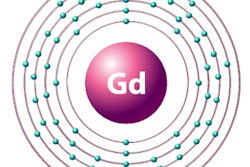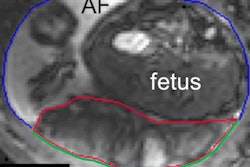
Pregnant women are four times more likely to undergo an MRI scan with a gadolinium-based contrast agent (GBCA) in their first trimester than in their final six months of pregnancy, a finding that indicates many are scanned before they know they are pregnant, according to a study published online August 20 in Radiology.
The greater frequency of first-trimester gadolinium-enhanced MRI scans is likely due to the fact that women are simply unaware of their pregnancy. As innocuous as that omission might be, the findings indicate that clinicians should be more diligent in screening women of child-bearing age prior to GBCA-enhanced MRI scans to help avoid any unforeseen adverse reactions from the contrast agent and any unnecessary accumulation of gadolinium that could affect newborns.
"This study identified higher rates of GBCA exposure during the first few weeks of pregnancy when compared with later weeks, suggesting inadvertent exposure to GBCAs may occur before pregnancy is recognized," wrote the authors, led by Steven Bird, PhD, from the U.S. Food and Drug Administration (FDA) Office of Surveillance and Epidemiology. "The high prevalence of unplanned pregnancies in the United States may contribute to failures to recognize early pregnancy among women who underwent MRI."
Gadolinium travels
Previous studies have raised the possibility that gadolinium-based contrast material can pass through the placental barrier and enter the fetal circulation. Naturally, the transmission of this toxic element prompts the question of whether a gadolinium-enhanced MRI scan is safe during pregnancy and to what degree pregnant women are exposed to the contrast material.
So far, studies are encouraging and indicate there are no serious adverse effects if and when a pregnant woman undergoes a first-trimester GBCA-enhanced MRI scan. A 2016 study by Ray et al compared 397 contrast-enhanced MRI exams of women in their first trimester against 1.4 million women in their first trimester who did not undergo an MRI scan.
While the researchers found no statistically significant difference in the risk of nephrogenic systemic fibrosis (NSF)-like outcomes and no association with an increased risk to the fetus or in early childhood development, GBCA-enhanced MRI during pregnancy was associated with "an increased risk of a broad set of rheumatological, inflammatory, or infiltrative skin conditions and for stillbirth or neonatal death," the authors concluded (Journal of the American Medical Association, September 6, 2016, Vol. 316:9, pp. 952-961).
More recently, a January 2018 preclinical study by Prola-Netto et al found trace amounts of the gadolinium administered to pregnant monkeys crossed the placenta and entered fetuses, with most of this gadolinium quickly returning back to the mother's bloodstream within 19 to 21 hours for excretion and leaving mostly undetectable levels of gadoteridol in the newborns.
"Given the potential risks of gadolinium exposure during pregnancy, we sought to examine the characteristics of real-world use patterns in a large sample of pregnant women," Bird and colleagues wrote.
The researchers reviewed records from 16 partners in the FDA Sentinel Distributed Database to tally some 4.6 million live births between January 2006 and December 2017. The data included 6,879 exposures to gadolinium contrast in 5,457 pregnancies, for a rate of one contrast-enhanced MRI exam per 860 pregnancies (0.12%). Half of the GBCA-enhanced MRI scans (3,499 exams, 50%) performed during pregnancy were of the head, followed by the pelvis and abdomen (1,536 exams, 22%).
Timing is everything
"Exposures to contrast-enhanced or unenhanced MRI also were categorized by gestational week to allow visualization of the exposure trend over time from four weeks prior to the last menstrual period until and including the hospital admission for delivery," the authors explained.
As for the timing of those scans, 70% of the GBCA-enhanced MRI exams were conducted during the first trimester, compared with 16% of the exams performed in the second trimester, followed by 14% in the third trimester. The first-trimester total is 4.3 times greater than the second trimester and 5.1 times greater than the third trimester.
| GBCA-enhanced MRI scans per pregnancy trimester | ||||
| 1st trimester | 2nd trimester | 3rd trimester | Total scans | |
| No. of GBCA-MRI scans | 4,008 (70%) | 925 (16%) | 779 (14%) | 5,712 |
"A trend can be seen toward decreasing use of GBCAs during weeks 3-7 of pregnancy, with a relatively stable GBCA exposure rate during gestational weeks 8-35," Bird and colleagues wrote. "A spike in contrast-enhanced MRI was noted at the time of hospital admission for delivery, particularly in week 40, which was the most common gestational week for delivery. This included 2,367 GBCA exposures during the hospital admission for delivery that were not included in our primary analysis."
Sage advice
Bird and colleagues emphasized that their data collection was based on diagnosis codes that were used to bill payors for the MRI scans. While they could determine indications for the exams, they were unable to draw any conclusions from the medical records on whether the use of a GBCA during the mother's MRI scan had any adverse effect on the newborn or "reliably" identify the specific GBCA and dose used in the imaging exams, they added.
In the meantime, both the American College of Radiology (ACR) and the FDA supports screening women of reproductive age for pregnancy before undergoing any MRI scan. The ACR also recommends GBCAs be used only after "careful consideration that the benefit to the mother, fetus, or both outweighs the unknown but potential risks," the authors noted.
Bird and colleagues also suggested a safety screening form to ask a patient about the possibility she could be pregnant, direct questioning of women by radiologic technologists regarding a pregnancy, prominently displaying signs in the imaging suite asking patients to notify radiology staff if they may be pregnant, and ask that a pregnancy test be performed when appropriate.



















